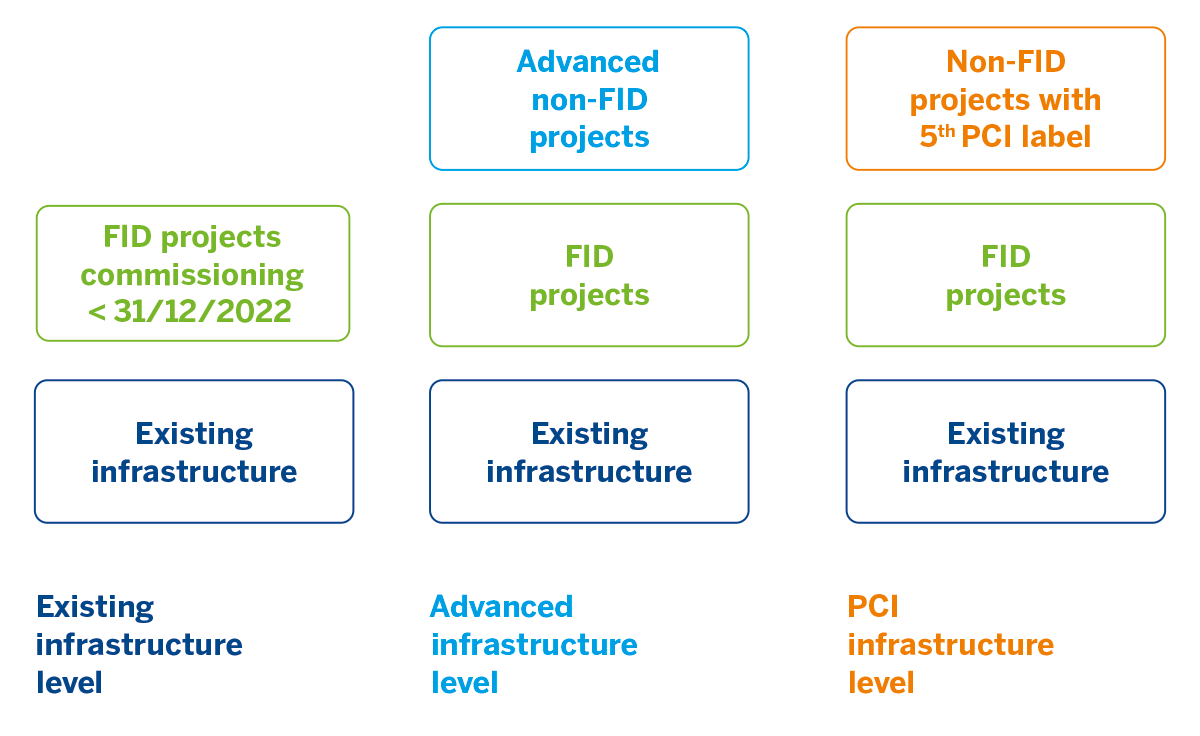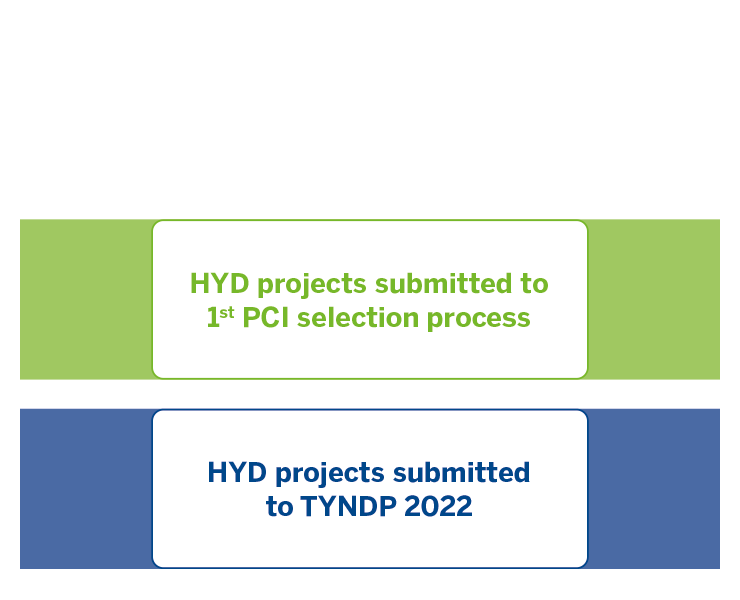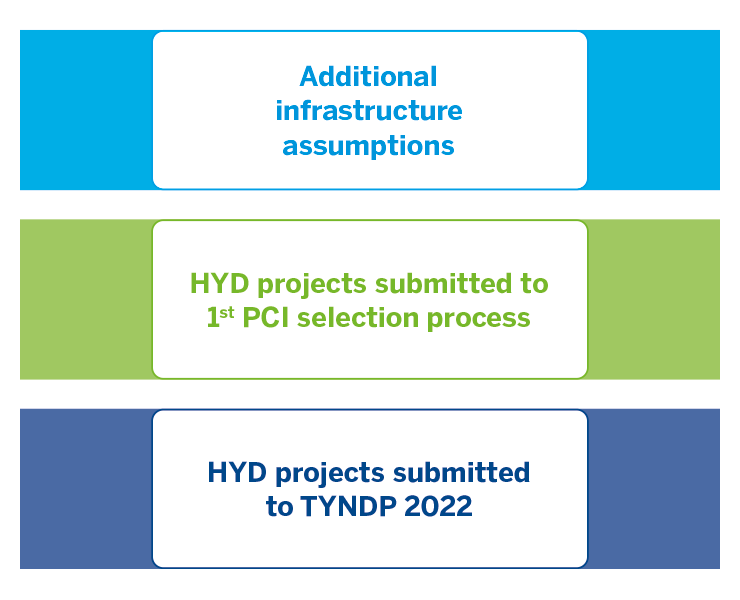4 Project Status and
4.1 Project status
Projects are categorised along two different project status: FID and non-FID. As for TYNDP 2020 the non-FID status has been sub-categorised into non-FID Advanced (hereafter Advanced) and non-FID Less-Advanced (hereafter Less Advanced).
Each project status is directly derived from the information provided by its promoter and according to the rules set in the ENTSOG Practical Implementation Document:
- The FID status of a project corresponds to a project that has taken the final investment decision before the closure of TYNDP project collection period. Projects with FID status are identified in TYNDP project code with a F (e. g. TRA-F-000);
- The Advanced status is applied to all non-FID projects that fulfils the following conditions:
- commissioning year expected at the latest by 31 December of the year of the TYNDP project data collection + 6 (e. g. 2028 in case of TYNDP 2022 for which the latest data collection was done in 2022)
- and
- whose permitting phase has started ahead of the TYNDP project data collection
- OR
- FEED1 has started (or the project has been selected for receiving CEF2 grants for FEED) ahead of the TYNDP project data collection.
- Projects with Advanced status are identified in TYNDP project code with an A (e. g. TRA-A-000)
- All projects that do not meet the FID or Advanced criteria are considered as having the Non-Advanced status. Projects with Non-Advanced status are identified in in TYNDP project code with an N (e. g. TRA-N-000).
Based on past TYNDP process experience and the recommendations expressed by ACER in their Opinions, the Advanced status was already introduced in the 2017 edition3 and allows to better reflect the different project maturities. This status was defined in close cooperation with ACER and the European Commission, and in consultation with stakeholders.
To enable meaningful simulation for system needs assessments, ENTSOG decided to move forward the project status of around 15 projects from less advanced to advanced. Most of these projects have been initiated directly after the Russian invasion of Ukraine aiming to bring additional supply to Europe or solving internal system bottlenecks. All respective projects have a common point: that the commission date and the realisation is very likely in the near future but based on the ad hoc planning all information on FEED and/or permitting could not be provided during the second project submission phase. Examples for this are investments at the border between France and Germany enabling reverse flow and the construction of FSRU’s in several European Countries. This decision was well discussed with all concerned project promoters.
Additionally, the PCI status is assigned to natural gas projects that are part of the latest approved 5th Union list of Projects of common interest (the PCI list) referred in Article 3 of the Regulation (EU) 347/2013, irrespective of the above-mentioned project status.
1 Front End Engineering Design as the basic engineering activity conducted after completion of the conceptual design or the (pre-)feasibility study.
2 The Connecting Europe Facility (CEF) is an EU funding instrument defined in Art. 14 of Regulation (EU) 347/2013
3 https://www.acer.europa.eu/Official_documents/Acts_of_the_Agency/Opinions/Opinions/ACER%20Opinion%2011-2015.pdf
4.2 Infrastructure levels
4.2.1 Natural gas infrastructure levels
As in previous TYNDP editions, project status is the basis for the definition of natural gas infrastructure levels:
- Existing infrastructure level
Existing infrastructure level is composed of the existing network + FID projects having their commissioning date no later than 31 December 2022.
Existing infrastructure level will be the basis for the following infrastructure levels (PCI and Advanced), as it represents the minimum level of natural gas infrastructure development that will be considered in the TYNDP 2022 System Assessment.
- Advanced infrastructure level
Advanced infrastructure level is composed of existing infrastructure level + FID projects + Advanced projects.
The advanced infrastructure level broadens the range of the TYNDP 2022 System assessment, by including the natural gas advanced projects on top of the existing and FID infrastructure allowing for a better and more complete infrastructure gaps identification.
- PCI infrastructure level
PCI infrastructure level is composed of existing infrastructure level + FID projects + natural gas infrastructure projects included in the 5th PCI list.
The PCI infrastructure level is composed by existing infrastructures, infrastructure projects having FID status (whatever their PCI status is) and infrastructure projects labelled as PCIs in the 5th PCI selection process (not having their FID taken yet). Although it includes projects of different maturity, this infrastructure level allows to build a bridge between past PCI selection processes and it also enables the assessment of the 5th list of PCI natural gas projects.
Figure 1: Natural gas infrastructure levels in TYNDP 2022
4.2.2 Hydrogen infrastructure levels
Unlike natural gas, hydrogen infrastructure levels can only be defined with the consideration of planned projects, as there is no existing infrastructure in place.
After the inclusion of ETR project category (Energy Transition projects) in the TYNDP2020, and in order to provide a more accurate and up to date representation of the latest infrastructure developments ENTSOG extended the projects categories of ETR projects into four new separate categories in TYNDP 2022. Among these new infrastructure categories further detailed in section 5.1 “Types of infrastructures”, Hydrogen infrastructure projects were collected as part of the dedicated new hydrogen project category.
In addition, hydrogen projects included different subcategories of hydrogen infrastructure projects, such as:
- On-shore or off-shore Hydrogen transmission pipelines (newly constructed or repurposed from natural gas pipelines) including pipelines enabling hydrogen imports from extra-EU countries.
- Newly constructed or repurposed liquefied hydrogen terminal including hydrogen embedded in other chemical substances with the objective of injecting the hydrogen into the grid.
- Hydrogen storages (newly constructed or repurposed from natural gas infrastructure)
Extensive data collection carried out for TYNDP 2022, allowed for the consideration of hydrogen infrastructure levels as a first step on the assessment and analysis of hydrogen infrastructure.
For the first time, in the TYNDP 2022 edition, ENTSOG has introduced Hydrogen infrastructure levels, that includes not only Hydrogen infrastructure projects (as defined in the Practical Implementation document of TYNDP 2022) submitted to TYNDP 2022, but it is also complemented by additional Hydrogen infrastructure projects submitted to the first PCI selection process under revised TEN-E (for which project collection closed in December 2022).
The addition of hydrogen projects submitted to the PCI project submission in the TYNDP 2022 edition is explained by the specific relationship between the TYNDP 2022 cycle and the ongoing first PCI selection process. As for the first PCI selection process, previous project submission to the TYNDP 2022 edition was not set a mandatory condition, unlike previous and future TYNDP/PCI processes.
It is also important to highlight that considering PCI project submission information as part of TYNDP 2022 infrastructure levels, has also allowed to update TYNDP 2022 project data of hydrogen infrastructure with the best available information from project promoters.
This is also reflected in the TYNDP 2022 System and Project-specific CBA assessment and will enable a fair and non-discriminatory analysis of future hydrogen infrastructure.
In addition, and as further detailed in the definition of the Hydrogen infrastructure levels some additional infrastructure assumptions are included for H2 infrastructure level 2.
Unlike natural gas infrastructure levels, hydrogen infrastructure levels are not based on project-status. As hydrogen infrastructure being at an early stages of development compared to natural gas infrastructure that has been gradually developed reaching already in the existing infrastructure level considerable level of development for most European countries.
As described later in section 7.5.1 “Overview of project status”, most hydrogen projects have non-FID less-advanced project status, whereas only few submissions have non-FID advanced project status and only one project has FID status.
In TYNDP 2022 two contrasted hydrogen infrastructure levels were included :4
4 Detailed capacities of Hydrogen Infrastructure levels 1 and 2 can be found on the Annex C2
- Hydrogen infrastructure level 1:
Hydrogen infrastructure level 1 is a project-based infrastructure level, is composed of all TYNDP 2022 hydrogen projects (including also TYNDP 2022 hydrogen-ready infrastructure), as well as hydrogen projects submitted to the first PCI selection process that were not previously submitted to TYNDP 2022.
- Hydrogen infrastructure level 2:
Hydrogen infrastructure level 2 is defined as a policy-based infrastructure, is composed of Hydrogen infrastructure level 1 and additional infrastructure assumptions based on TSOs’ needed to enable policy objectives, such as the 2030 hydrogen imports targets defined the RePowerEU Plan.
Figure 2: Hydrogen infrastructure levels in TYNDP 2022
Infrastructure levels are the basis for the identification of infrastructure gaps in the TYNDP 2022 System assessment. For the first time, TYNDP 2022 will include a dual assessment of natural gas and hydrogen infrastructure: by combining each natural gas infrastructure level with both hydrogen infrastructure levels in the TYNDP System assessment. As for the hydrogen system an existing infrastructure level is not yet available. ENTSOG has identified a possible hydrogen network according to the information provided by promoters in their project submission for TYNDP/PCI process (i. e. H2 infrastructure levels).
For this reason, it should be clear that the System Assessment shows results that could be reached (in 2030, 2040, 2050) under the hypothesis of a full commissioning of H2 planned infrastructures that are not yet in place. Therefore, even in configurations where no demand curtailment are identified these results should not be read as the absence of H2 infrastructure needs. On the other hand, it is assumed a full availability of the infrastructures composing the H2 infra levels in order to avoid demand curtailment. Indeed, if planned infrastructure is not developed, demand curtailment would materialise at rates progressively increasing together with the number of planned project not actually realised.
Figure 3: Natural gas and Hydrogen infrastructure levels in the System Assessment





